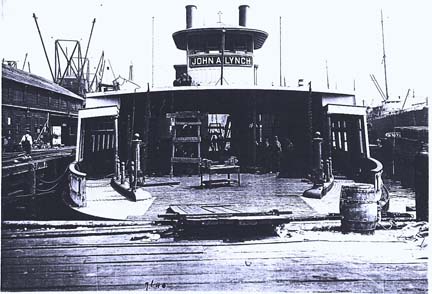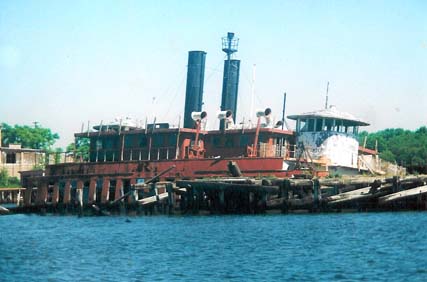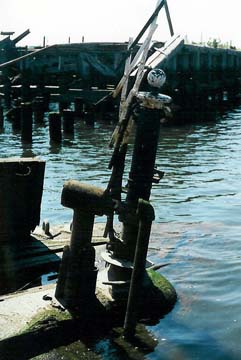
Hart being built in 1925 with former name
Courtesy of South Street Sea Port

Hart being built in 1925 with former name
Courtesy of South Street Sea Port
The Major General William H. Hart was built in Mariner`s Harbor, Staten Island in 1925 as the John A. Lynch. After the Mayor Hylan campaign scandals (in which to gain favor of political allies, he name a ferryboat after sixteen influential politians), the boat was renamed by the new mayor, the Harlam. The boat, which was one of the vessels built for the "essential" New York ferry routes, operated between the Bronx and Queens, as a Class C Municipal Ferry. The vessel operated for this route until the route became surplus midcentury, where it then took up operations at the army base on Governor`s Island. Here she took up her third and final name, Major General William H. Hart. The vessel`s route was defined to be between Governor`s Island terminal and the nearby South Ferry Terminal. When the island switched hands (Army to Coast Guard), the vessel went with it. At this time an upper deck was istalled on the vessel to carry passengers. In 1968, the ferry made its last crossing and was donated to South Street Sea Port in that year.
After being transfered, the boat was operated as a maritime school (Pioneer Marine School). She sat their in such operation until 1990 when due to a collapsing pier, she was sold to Mystic Sea Port in Connecticut. In 1998, the veteran ferry was again sold this time to a private investor, whom had requested it to be towed down to a point on the Jersey Coast. After the boat had arrived at the predetermined spot, the tug waited for several hours for pickup, with no avail and the boat was left docked at a pier, where it sits half sunk today. Of special interest, the boat was put onto the National Registry of Historic Ships, not far after her abandonment.
Being aboard the vessel myself a few years ago, I found her to be quiet sound as far as shipwrecks go, with the exception of the lower decks where wooden planks are being replaced by holes. The most evident factor of her strength is the barbeque sitting in her main passenger deck, which seems to suggest the vessel is visited fairly often. As for her upper passenger deck in general, the benchs and paint job are in great condition, although it looks like the maid forgot to visit when it comes to cleanliness. Her pilothouses have been emptied of anything remotely maritime related. Her lowers decks show the eight degree list in the boat to its fullest. What is now the northern end of the lower passenger decks is always submerged, but the southern deck comes out of the water at low and mid tides. Of architectural interest, this vessel contains a cst iron spiral staircase, which is still in good repair (as of last visit). As for her engine rooms, I have not been in them or care to be. These compartments are perpertially flooded and dark. DO NOT ENTER THESE COMPARTMENTS.
Her uppermost deck, the Hurricane Deck, is also in good shape. Seeing her lifeboat devits in a lauch position, with the lifeboats missing tells the tale of a sunken ship, although these were probably removed long before this terrible fate. Her two smokestacks retain there paint, and head all the down to the old steam engines. Directly between them is the crow`s nest. It stands about twenty feet or more above the deck, and provides a view of the entire vessel, Witte`s Scrapyard, and a large part of the Arthur Kill. Of all the wrecks I have been aboard so far, this one is my personal favorite.
August 22, 2005
The condition of the Major General William H. Hart have deteriorated much since the August 2000 trip to her. The upper decks are still in fair condition, and be walked on; however do to vandals most of the chairs, doors and windows aboard the old ferryboat have been destroyed. In addition to this, it was found in June of 2004, that the lifeboat davits were some how removed from the ferry on both sides, and to add to this the list onboard the ship has worsen by 175%. In 2000, she listed 8 degrees North, and now list 14 degrees to the North.
The damage taken by the lower decks is exponential to that taken by the upper decks. In 2000, the wooden planks were intact enough to walk very slow and cautiously on, with holes in the planks being on a here and there basis. Currently, the south side passenger cabin could now be entered by means of a small kayak (which is unfortunately possible) only. The reason for this is a 31 foot section of the lower outer hull has collapse, and disappeared into the murky waters. The collapse area runs just about midship, and goes as high as the bottom portion of the lower passenger deck windows.
Metal samples have been taken from the upper deck to begin to determine the state of the metal located aboard ship. Results to be determined

Overall view comming south


Right: Spiral Staircase to Lower Deck
Left: Smoke Stack from crows nest. Not recomended for those afraid of heights

Lower deck gate post to block in passengers